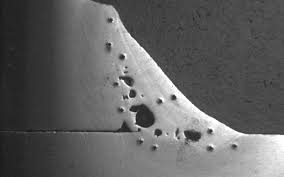What is Porosity in Welding: Trick Aspects and Their Effect On Weld Top Quality
What is Porosity in Welding: Trick Aspects and Their Effect On Weld Top Quality
Blog Article
The Scientific Research Behind Porosity: A Comprehensive Overview for Welders and Fabricators
Recognizing the detailed mechanisms behind porosity in welding is important for welders and producers making every effort for impressive workmanship. From the structure of the base products to the complexities of the welding procedure itself, a wide variety of variables conspire to either aggravate or ease the existence of porosity.
Understanding Porosity in Welding
FIRST SENTENCE:
Exam of porosity in welding discloses important insights into the honesty and high quality of the weld joint. Porosity, characterized by the presence of dental caries or gaps within the weld steel, is a common concern in welding procedures. These voids, if not correctly resolved, can jeopardize the architectural stability and mechanical properties of the weld, resulting in possible failings in the completed item.

To detect and quantify porosity, non-destructive testing techniques such as ultrasonic screening or X-ray inspection are frequently used. These strategies permit the identification of internal defects without endangering the honesty of the weld. By analyzing the size, shape, and distribution of porosity within a weld, welders can make enlightened choices to enhance their welding procedures and attain sounder weld joints.

Variables Affecting Porosity Development
The event of porosity in welding is affected by a myriad of variables, varying from gas securing performance to the intricacies of welding parameter settings. One vital factor contributing to porosity development is inadequate gas protecting. When the protecting gas, commonly argon or carbon dioxide, is not efficiently covering the weld swimming pool, atmospheric gases like oxygen and nitrogen can contaminate the molten metal, resulting in porosity. Additionally, the cleanliness of the base products plays a significant role. Contaminants such as corrosion, oil, or dampness can evaporate during welding, creating gas pockets within the weld. Welding specifications, consisting of voltage, present, travel rate, and electrode kind, likewise impact porosity development. Using incorrect setups can generate too much spatter or warm input, which in turn can lead to porosity. In addition, the welding method utilized, such as gas metal arc welding (GMAW) or protected metal arc welding (SMAW), can affect porosity formation because of variants in heat circulation and gas protection. Recognizing and managing these elements are essential for decreasing porosity in welding operations.
Impacts of Porosity on Weld High Quality
Porosity development considerably compromises the architectural honesty and mechanical buildings of bonded joints. When porosity is existing find out here in a weld, it creates spaces or dental caries within the material, decreasing the general toughness of the joint. These spaces work as stress concentration factors, making the weld extra susceptible to cracking and failure under tons. The existence of porosity additionally weakens the weld's resistance to corrosion, as the caught air or gases within deep spaces can respond with the surrounding setting, leading to deterioration with time. In addition, porosity can hinder the weld's ability to endure pressure or effect, additional jeopardizing the overall top quality and reliability of the welded structure. In vital applications such as aerospace, vehicle, or architectural building and constructions, where safety and security and toughness are paramount, the harmful effects of porosity on weld quality can have severe consequences, emphasizing the importance of decreasing porosity with appropriate welding methods and procedures.
Techniques to Minimize Porosity
In addition, making use of the appropriate welding specifications, such as the right voltage, present, and take a trip rate, is crucial in preventing porosity. Maintaining a consistent arc length and angle during welding also helps decrease the probability of porosity.

Utilizing the proper welding method, such as back-stepping or employing a weaving activity, can additionally assist distribute heat equally and minimize the chances of porosity development. By carrying out these strategies, welders can successfully reduce porosity and produce high-grade bonded joints.

Advanced Solutions for Porosity Control
Carrying out innovative technologies and ingenious techniques plays a crucial duty in attaining remarkable control over porosity in welding procedures. Additionally, utilizing sophisticated welding techniques such as pulsed MIG welding or customized ambience welding can additionally help reduce porosity concerns.
Another innovative remedy involves the use of innovative welding tools. Making use of equipment with integrated attributes like waveform control and advanced power sources can improve weld top quality and lower porosity dangers. In addition, the execution of automated welding systems with specific control over specifications can substantially lessen porosity issues.
In addition, including innovative surveillance and examination technologies such as real-time X-ray imaging or automated ultrasonic screening can assist in detecting porosity early in the welding web process, enabling prompt rehabilitative actions. Overall, integrating these advanced solutions can significantly boost porosity control and boost the general browse around these guys high quality of welded components.
Verdict
In verdict, comprehending the scientific research behind porosity in welding is vital for welders and producers to produce top notch welds - What is Porosity. Advanced services for porosity control can better boost the welding process and make certain a strong and reliable weld.
Report this page